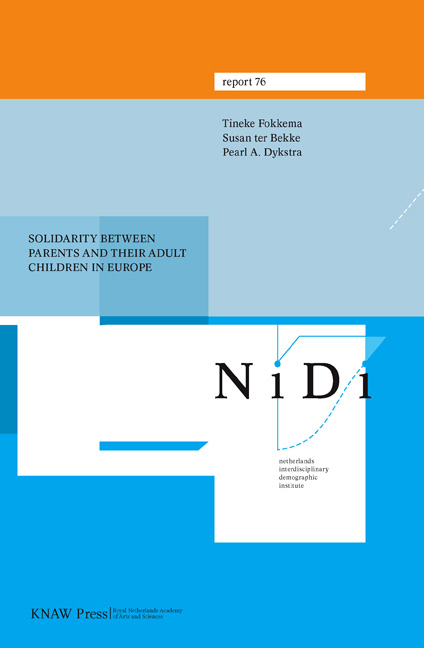Book contents
- Frontmatter
- Contents
- List of Figures
- List of Tables
- Executive Summary
- Acknowledgement
- 1 Introduction
- 2 Geographical Proximity
- 3 Contacts
- 4 Family Care Obligations
- 5 Support Exchange
- 6 Typology of Late-Life Families
- 7 Conclusion and Discussion
- References
- Appendix Measurement of the Independent Variables
- List of NIDI Reports
3 - Contacts
Published online by Cambridge University Press: 20 January 2021
- Frontmatter
- Contents
- List of Figures
- List of Tables
- Executive Summary
- Acknowledgement
- 1 Introduction
- 2 Geographical Proximity
- 3 Contacts
- 4 Family Care Obligations
- 5 Support Exchange
- 6 Typology of Late-Life Families
- 7 Conclusion and Discussion
- References
- Appendix Measurement of the Independent Variables
- List of NIDI Reports
Summary
Introduction
Contact frequency between parents and their adult children is the central issue of this chapter. Like geographical proximity, regular contact is needed to exchange support. The more contact there is, the easier it is to give and receive support and to identify whether support is needed. Contact frequency is sometimes seen as a form of support in itself as it meets a social need. It is also an indirect indicator of a range of types of support that are difficult to measure (Kalmijn & Dykstra, 2006). It is worth noting that frequent contact may also be associated with negative interactions. There is a growing awareness, however, that high levels of both contact and conflict (ambivalence) do not automatically imply that the parent-child relationship is of low quality (Van Gaalen, 2007).
In the SHARE questionnaire, respondents were asked about the frequency of contact with at most four children: ‘During the past 12 months, how often did you (or your husband/wife/partner) have contact with [child name], either personally, by phone or mail?’. The answer categories were: (1) daily, (2) several times a week, (3) about once a week, (4) about every two weeks, (5) about once a month, (6) less than once a month, and (7) never. Assuming that parents have daily contact with coresident children, the contact question is asked for non-coresident children.
First, country differences will be presented with regard to contact frequency on its own and in relation to conflict (figure 3.1, figure 3.2 and figure 3.3) and the average number of children with whom parents were in contact once a week, several times a week or daily (figure 3.2). Our focus will then shift to the bivariate relationship between parent-child contact on the one hand and several personal characteristics on the other hand, with special attention to the parents’ and children's gender, family size, and parental divorce (table 3.1, table 3.2, table 3.3 and table 3.4). For these descriptive analyses, different indicators of contact frequency at the level of the parent were considered, including frequency of contact with the most contacted child, the percentage of parents having daily contact or more than weekly contact, the percentage of parents having no contact with the children, the total number of contacts across all children, the variation in contact frequency between children and the mean annual number of contacts per child.
- Type
- Chapter
- Information
- Publisher: Amsterdam University PressPrint publication year: 2008



